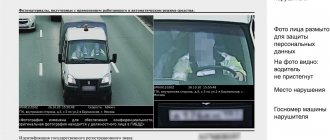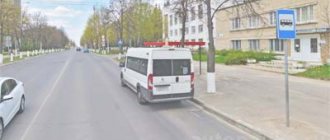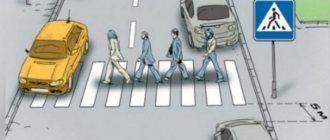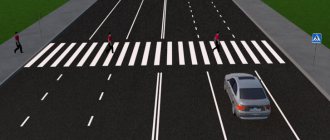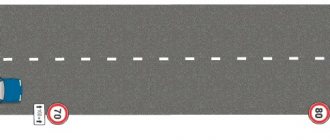What is the permissible distance to a zebra crossing for parking?
5 meters . This is regulated by paragraph 12.4 of the Road Traffic Regulations, which directly prescribes the following:
12.4. Stopping is prohibited:
- ….
- at pedestrian crossings and closer than 5 m in front of them;
That is, it is prohibited to stop not only closer than the specified distance to the pedestrian path, but also at the zebra crossing itself.
Fine for violating parking rules
The most common measure of liability that is provided for parking at a pedestrian crossing in 2021 is a fine in the amount of 1 to 3 thousand rubles. If a motorist is caught violating Article 12.4 of the Traffic Rules for the second or third time, then a more severe punishment will be applied to him:
- Evacuation of a vehicle followed by arrest for up to 5 days;
- Withdrawal of driver's license for a period of 3 to 6 months.
In this case, it is advisable to pay the imposed fine within the first 20 days from the date of drawing up the administrative protocol. In this case, the violator will be able to get away with compensation of only half of the financial penalty. But after two months, the amount indicated on the traffic police form, on the contrary, will double. And then the citizen will have to pay double for his crime.
It is also worth noting that if an employee of the State Traffic Inspectorate did not have time to record a car parked in a prohibited area, or was unable to document how many meters the vehicle was parked before the pedestrian crossing, then a fine for 2021 can be avoided by appealing the traffic police decision in court. After all, in the absence of evidence, traffic cops do not have the right to initiate an administrative case. Otherwise, they themselves will be held accountable.
How to count 5 meters?
12.4 of the Rules does not indicate to what exact place these 5 meters should be counted - it only prescribes that to the object itself. Therefore, in order not to make a mistake, we need to know at what point the pedestrian crossing begins - that is, its boundaries. And the traffic rules also speak about them quite clearly in the very definition of a zebra:
Pedestrian crossing is a section of the roadway, tram tracks, marked with signs 5.19.1, 5.19.2 and (or) markings 1.14.1 and 1.14.2 and allocated for the movement of pedestrians across the road. In the absence of markings, the width of the pedestrian crossing is determined by the distance between signs 5.19.1 and 5.19.2.
5.19.1 and 5.19.2 are respectively square-shaped signs (see diagram above):
- the first one is installed to the right of the roadway and marks the beginning of the crossing, before which you can park only 5 meters away,
- the second is on the left and indicates the end of the transition.
But if there are markings, the boundary is determined by it, and when figuring out how many meters you can park before the pedestrian crossing, you need to be guided by the presence of markings:
- if there is a marking, then 5 meters in front of the zebra must be counted to the beginning of the marking line,
- if there are no markings, then count to the right sign.
The question is even more difficult: how to determine how much it will be - 5 meters? After all, not every driver carries a tape measure with him! But here, too, everything is simple - if you are not sure about the sufficient distance, then place it further away or not at all if the parking spaces in the back are occupied. Because the traffic police inspector who will issue the fine will have a tool for measuring distances.
Of course, your inability to measure exactly how many meters before the crossing will not be grounds for canceling the punishment.
Is it possible to park behind a pedestrian crossing?
Motorists are often interested in this issue, since nowadays zebras are found at almost every step, which complicates the process of choosing a parking space. Let's define the concepts.
A pedestrian crossing is intended for people who want to cross the road. As a rule, it is indicated by special markings in the form of a zebra, as well as road signs with a walking man, familiar to everyone from childhood.
Pedestrian crossing sign and markings (zebra crossing)
Sometimes the markings are erased or become invisible under a layer of snow or dirt - in this case, you need to rely on the installed signs. That is, the distance between them informs drivers about the boundaries of the pedestrian crossing.
It’s interesting that the foreign word “parking” is simply not in Russian traffic rules. There is parking. She assumes that:
- the driver intentionally stopped the vehicle;
- the time that the car will stand will exceed five minutes;
- the reason that forced the car owner to stop has nothing to do with the disembarkation (boarding) of passengers, as well as with the loading (unloading) of the vehicle;
- The car is parked parallel to the roadside (unless otherwise provided by signs) or in a place specially designated for parking purposes.
Traffic regulations do not prohibit parking after a pedestrian crossing. Why? To answer this question, you need to understand - what is the seriousness of parking next to a zebra crossing? With the safety of those who will walk across the road. If you park your car immediately after the crossing, this will not disturb either pedestrians or other drivers, since their view of the zebra crossing will not be blocked.
See also: Fine for a pedestrian - if you didn’t miss it
Important: It is permissible to park immediately behind the pedestrian crossing. The distance from the zebra does not matter in this case.
Underwater rocks
Now let's look at a number of subtleties in which you can make a mistake with your knowledge of the Rules, since in these cases you cannot park even closer than 5 meters.
This is a small list of exceptions that nothing is written about in the 2021 traffic rules, but which may cost you the loss of your budget to pay a fine.
Parking may be completely prohibited on the road section
These are a number of conditions under which you simply cannot park your car in this place, and the pedestrian crossing has nothing to do with it at all. These include cases when:
- there is a bus lane on the right (section 18.2 of the traffic rules),
- all the spaces are already occupied, and you can’t park in the second row (clause 12.2),
- you are on a bridge or overpass (clause 12.4),
- you are on a highway outside a populated area and are going to park your car for a long time (clause 12.3),
- to a solid or double solid line less than 3 meters (clause 12.4),
- you will block road signs or traffic lights for others, for example, when driving large vehicles:
How many meters to a stop, railway crossing or intersection?
In addition to the direct ban on stopping in certain places listed above, there is also a ban on parking closer than a certain distance to other objects on the road.
- If the crossing is located further than 5 meters, but beyond the intersection of roadways, then the distance must be measured before such an intersection, and it must also be at least 5 meters, according to paragraph 12.4 of the traffic rules.
- Crossings are often located near stops, and before and after stops there should be at least 15 m. The border in this place is indicated by a stop sign or markings, so when figuring out how long you can park before a pedestrian zebra crossing, you need to count not only 5 meters before it, but and 15 to the beginning of the stop border.
- If there is an intersection with a bicycle path in front of the zebra, measure 5 m to the last one.
- If you are going to park for more than 5 minutes, then this is already parking, and it is prohibited within 50 m of railway crossings. Therefore, even stopping after a pedestrian crossing, you are violating.
What is parking and parking
Parking is a specially designated or equipped place that is part of a highway, or adjacent to a roadway, sidewalk, roadside or bridge. It is intended for organized parking of vehicles.
Parking is a cessation of vehicle movement for more than 5 minutes, which is not associated with boarding passengers or unloading cargo. Parking lot - the car was left, for example, in the yard near the house, and the driver is no longer going to drive it anywhere today.
The main differences between parking, stopping and parking:
- Parking lot: A place where a vehicle is placed in a non-operational state and left for a short period of time. The car is not guarded during long-term parking. You can leave your car for free for a short period of time.
- Stopping: intentionally stopping movement for up to five minutes. In this case, people are disembarked or embarked, cargo is unloaded or loaded.
- Parking: cessation of traffic for more than five minutes, which does not involve boarding passengers. The driver is not required to report the reasons for it.
What's the fine?
The penalty for parking closer than 5 meters to the crossing or directly within its boundaries is provided for in Part 3 of Article 12.19 of the Administrative Code, and the driver will be fined 1,000 rubles. This violation can be recorded by an automatic recording camera, so if you are not punished by a traffic police officer, you may still receive a “letter of happiness.”
But this fine is for Russian cities, except Moscow and St. Petersburg. For the latter, an increased amount of the fine is provided for in Part 6 of the same article. And you will have to pay 3 thousand if you committed a violation in one of these cities.
If you turn on the emergency lights
Many people do this, but almost always to no avail. The fact is that an emergency signal is considered an attribute of a forced stop... But with great understatement. Another attribute is the exposed warning triangle. This is what you need to do if you cannot drive further due to technical or other objective reasons and parked in a prohibited place.
But the inspectors are also not fools, and when they see the hazard lights on a car that is parked closer than 5 meters in front of a zebra, they will count how many meters the car is parked before the crossing and issue a fine, and then you run and prove that the stop was forced. Unfortunately, trying to avoid punishment in this way is bad.
Can you be at fault for an accident with a pedestrian?
Let's imagine a situation: you violated the Rules and parked less than 5 m in front of a zebra. This provoked an accident with a pedestrian being hit - another driver who was driving did not have time to react in time to the person who came out from behind your car, and was unable to achieve a complete stop by braking.
Who will be to blame in this case? The answer to this question becomes clear if you know how accident cases are considered by officials and judges. When determining guilt, the question is raised about whose violation led to the accident. And to make it even more obvious, the opposite question is posed: the absence of violation of which of the participants would have allowed the incident to be avoided?
And there are two violators here - the driver of the red car in the diagram violated paragraphs 14.1 and 14.2 of the traffic rules, since in any case he is obliged to ensure the safe passage of the zebra crossing.
In theory and logically, it would seem that the fault here is mutual for the drivers of both cars. But in judicial practice, courts are most often inclined to blame the driver of the red car.

